India Travel Journal: Uttar Pradesh
| This travel journal is part of a series of journals, which are all written during a long trip between november 2007 and may 2009. |
> Goodbye to Pokhara
05-11-2008 After a sunny departure from Pokhara, with a last view of the Himalayas, we soon approach the morning fog of the Terai in the South of Nepal. The landscapes are truely beautiful, with green hills, authentic villages and clear waters. We're surprised by the great number of landslides. From time to time the road's completely vanished and we bump through a field of pebbles. Right after Butwal the hills are suddenly gone and we drive the last kilometers through the plains, where rice is being harvested.
> The Border with India
 In Bhairawa the bus stops at a small bus station and we hop in the rikshaw of the tiniest man we've seen in Nepal. Still he manages to get his bicycle moving, but we do make a stop for some extra air in the right rear tire. We pass long queues of trucks, waiting for the border checks and fifteen minutes later we're dropped at the Immigration Office. We go get our stamps and walk through the big gate: Welcome to India!
In Bhairawa the bus stops at a small bus station and we hop in the rikshaw of the tiniest man we've seen in Nepal. Still he manages to get his bicycle moving, but we do make a stop for some extra air in the right rear tire. We pass long queues of trucks, waiting for the border checks and fifteen minutes later we're dropped at the Immigration Office. We go get our stamps and walk through the big gate: Welcome to India!The chaos on the other side is overwhelming. Trucks are horning while roaring, rikshaws are using their bells while slaloming around them and the police are scaring away beggars with limbs as thin as matchsticks. On both sides we see shops selling all kinds of junk and among them we're looking for the Indian Immigration Office. Did we just miss the place? We ask a security guy, who tells us to continue for another hundred meters, so we walk in the direction which we're pointed to. Indeed we suddenly see a man sitting behind a desk with an "Immigration" sign above his head, right there on the street, under a shelter, amidst all the horns, bells and exhaust fumes.
A little later we also got the right stamps from this guy and we're trying to find an ATM. Which happens not to be there. How inconvenient, since we don't have any Indian rupees yet and we've only got a small quantity of Nepalese left. We try to exchange these, so that we can at least buy some bus tickets to the next city. However, there's only one shop wanting to exchange money and without a second look our money is taken and a stack of Indian money is thrown in front of us. Not nearly enough, so we see when counting. Turns out this guy is charging 25 percent of commission! Take it or leave it he says, there's no other option to exchange Nepali rupees.
Well, we have another opinion about that and we demand our Nepali rupees back. Without even a glance in whatever direction we walk the hundred meters back to Nepal. The police are way too occupied shooing the beggars from the border area and there's enough commotion and noise to stay unnoticed. Like this we first pass the Indian border post and a hundred meters further on the Nepali border post. Only when we're almost at the first exchange office on Nepalese soil we're being noticed, but just by a "friend" who can help us with transportation to "anywhere in Nepal". We snarl the guy to get rid of him before our plan fails and we quickly proceed to the window, where we get Indian rupees against an excellent rate. Then we do the same trick once more and we slalom back to India through all the fuss. Again no one is bothering us, so after this illegal little trip back into Nepal we can thumb our noses to the exchange thief who was trying to cheat us.
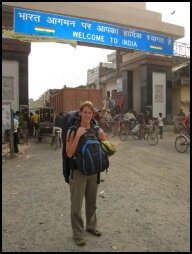 We're able to claim the last two seats in the bus to Gorakhpur, even though these seats are no real seats but just a simple platform next to the driver. Folded between three men, two women and a whole bunch of kids we're driving into India, seated backwards. Chaos on the road is unbelievable. Everybody is cycling, driving and walking pell-mell and the horns on trucks and buses are deafening. The sun is a red sphere in a blue sky, behind a thick, grey haze of air pollution and moist. In the fields the leftovers of what used to be rice plants, until last week, are being burned. Harvest is almost done and then everything starts over again.
We're able to claim the last two seats in the bus to Gorakhpur, even though these seats are no real seats but just a simple platform next to the driver. Folded between three men, two women and a whole bunch of kids we're driving into India, seated backwards. Chaos on the road is unbelievable. Everybody is cycling, driving and walking pell-mell and the horns on trucks and buses are deafening. The sun is a red sphere in a blue sky, behind a thick, grey haze of air pollution and moist. In the fields the leftovers of what used to be rice plants, until last week, are being burned. Harvest is almost done and then everything starts over again.In Gorakhpur there's even more fuss and the horning is like an endless sound here. Meanwhile it got dark, but even that can't completely hide the ugglyness of this city. The first hotels where we take a look are extremely dirty and we decide to try the most expensive one from our travel guide. After all it's really fun to splurge for 8 Euros a night. Here it's also not really clean, but it's the best we've seen so far and at least there's hot water coming from the tap. The beds are thin mats on wooden planking, like we've seen them in all the other rooms as well. We don't sleep any less, since we're really tired after this long day of traveling.
06-11-2008 By day Gorakhpur is even more disgusting than at night. Dust is blowing around from under the brooms of sweeping wallahs, dirt is burning and smokes and stinks like hell, both kids and adults are defecating in the gutters, skinny stray dogs and fairly fat cows are poking around in the garbage and every road user is trying to produce as much noise as possible to be seen and heard.
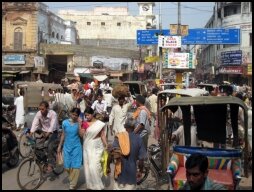 We buy train tickets for tomorrow morning and we find out what we can or can't eat here, not an easy thing when paying attention to hygiene.
We buy train tickets for tomorrow morning and we find out what we can or can't eat here, not an easy thing when paying attention to hygiene.
> To Varanasi
07-11-2008 At four thirty am the alarmclock rings. In a rikshaw we ride to the station, through a city that's still dark. We see people sleeping under filthy rags everywhere and at many junctions small groups of cows are lazily ruminating. It's very busy at the station, even at this hour, and like all the other people we slalom around even more sleeping jumbles to our train. The railcars for non reserved and thus cheap tickets are already full, but the part for reserved chairs where we're seated do still have plenty of space. It turns out to be a sleeper compartment and there are even sheets and blankets. Unfortunately sleeping is not an option anymore, since a German fellow traveler is so full of himself that he likes to share this non-stop with us. Even the mp-3 player is not helping, he even bables right through it.
We're crossing flat landscapes with subtropical vegetation and rice paddies. Here and there we see villages of clay and thatch that wouldn't look out of place in Africa. There's no plumbing, so everybody is washing in the brown ditches along the tracks, in which others are defecating. All kinds of livestock are roaming the villages.
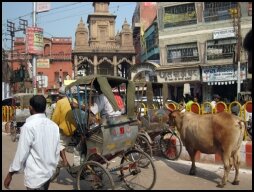 Varanasi is busy, but less dusty and smoky than Gorakhpur. An autorikshaw guy who promises he won't cheat on us (yeah right), or drop us at one of the many shops to spend money against our will (sure) quickly and smoothly drives us through the well-asphalted lanes of the city. In front of a hotel we'd like to check out we pay him and say goodbye. However, he stays and waits for a commission that needs to be payed by the hotel and at our expense, as soon as we agree on the excessive room rate. We don't take the room, since there's a lot of noise due to the construction that's going on here and when we walk out the door to find ourselves another place to sleep the rikshaw driver follows us in his cart. He's whining about his commission. We've got plenty of travel experience in Asia and enough reading experience on India to know that a discussion will not be helpful here and we keep on walking.
Varanasi is busy, but less dusty and smoky than Gorakhpur. An autorikshaw guy who promises he won't cheat on us (yeah right), or drop us at one of the many shops to spend money against our will (sure) quickly and smoothly drives us through the well-asphalted lanes of the city. In front of a hotel we'd like to check out we pay him and say goodbye. However, he stays and waits for a commission that needs to be payed by the hotel and at our expense, as soon as we agree on the excessive room rate. We don't take the room, since there's a lot of noise due to the construction that's going on here and when we walk out the door to find ourselves another place to sleep the rikshaw driver follows us in his cart. He's whining about his commission. We've got plenty of travel experience in Asia and enough reading experience on India to know that a discussion will not be helpful here and we keep on walking.The room in the next hotel seems clean and good enough, so we stay, but only after explaining the owner about the rikshaw wallah outside, who doesn't let up and even enters to get redress when we're registering. We ignore him and can even hear the heated discussion he's having with the hotel owner. They'll have to sort it themselves. We'll be enjoying lunch on the rooftop terrace and take a nap afterwards. Due to all the activity in the temple at the Ganges that's not as easy as it seems. All afternoon they're singing and praying through a microphone. The noise level is of the type: earsplitting and impossible to ignore.
> The Ghats of Varanasi
08-11-2008 Somewhere they came in last night: the mosquitos trying to bleed us out. We've stopped them by sleeping under our mosquito net for the very first time. Now we haven't been dragging the thing along for such a long time either.
Still not really awake we go for a morning stroll along the Ganges. That sounds quite romantic, but in reality you're being asked to come for a boat ride, to have your hands covered with henna, or to buy Marigolds for Shiva, Vishnu or any other God, every one hundred meters. Then we haven't even mentioned the beggars, who would like to have some food, drinks or money.
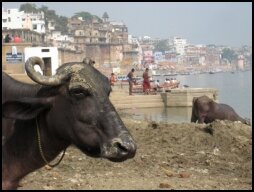
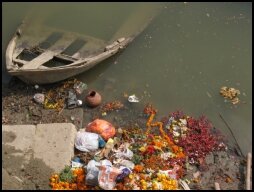
Still it's, compared to what we've seen in the rest of India, quite peaceful at the water. There's something to see at each Ghat (stairs by the riverside where people are making their pujas), but it's not as overwhelming as an autorikshaw ride through the center. A man is walking in circles around the center of an open temple, women and men are doing their laundry next to the place where the sewer pipe ends up in the Ganges, a family smears pink coloured powder on the back and the head of a cow and then they rub the animal's tale over their foreheads, music and prayers are blaring over the water, through huge speakers and kids play and wash themselves right next to the men who are sweeping the remains of cremated people into the river. The cremations seem to be going on the whole day, in the open air along the river. Huge piles of fire wood are brought in by boat and accurately weighed, before the deceased is put on top and all of it is lit. In some places the thick layer of mud left on paths and stairs by the monsoon is being removed under the pressure of fire hoses. A man warns us: "watch out, there very dirty". Ah, that mud is very dirty, while we've been slaloming around the remains of offerings, vomit, drains smelling like urine, waste and cow pies for the past few days. Well, we'll be careful indeed!
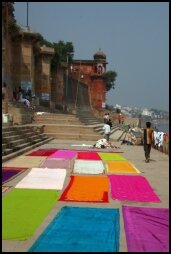 After having breakfast at a bakery we walk back to our room, while checking out the ceremonies performed by people at the waterside every now and then.
After having breakfast at a bakery we walk back to our room, while checking out the ceremonies performed by people at the waterside every now and then.
In the afternoon we get to the station by cycle rikshaw, since we've heard it isn't always easy to come by train tickets and we'd like to catch the night train to Agra tomorrow night. In the special tourist-office we have to wait for almost two hours before it's our turn and since we don't feel like spending so much time at a station again in a few days we decide what our next destination will be as well. Each of us carrying two train tickets for two classes lower and a day later than we'd hoped for we're leaving the station.
09-11-2008 Just before sunrise we get up to take a closer look at the ceremonies used to worship the sunrise. At Assi Ghat, the first Ghat we approach, it's already very busy. It's a cacophony of colours, smells and sounds. People dive into the river, light candles and insense, scatter colour powder, offer yellow and orange Marigolds which are eaten by cows and goats and perform group ceremonies where everyone is holding a branch or a blade of grass and all are singing. 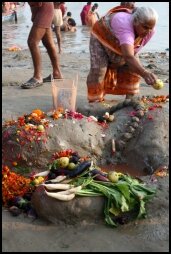 At a reclining figure made of clay, called the son of the river Ganges, food is sacrificed and a few women are walking around in circles while taking turns in touching the head of the riverson. The day hasn't even started yet and it's already filled with heated activity.
At a reclining figure made of clay, called the son of the river Ganges, food is sacrificed and a few women are walking around in circles while taking turns in touching the head of the riverson. The day hasn't even started yet and it's already filled with heated activity.
A little further on we're going for a boat ride, but only after bargaining hard. Our boatman steers along the shore, so we can take a good look at the former palaces and the ceremonies by the riverside. The main Ghats are overcrowded now with hundreds of people who came here from all over India to do their own things.
We walk back to the hotel for breakfast and only by the end of the afternoon we go out again, this time to be present at the Ganga Aarti ceremony, where mother Ganges is honoured. We find ourselves a spot on some steps, amidst all the Indian faithful. Some of them traveled more than thousand kilometers to be here. Today is generally the first day of the Ganga Mahotsav festival, the most important Ganges festival of the year.
The ceremony is a combination of music, bells, fire, insense and fireworks, an impressive experience for us.
> To Agra by Train
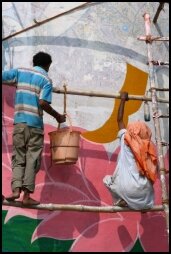 10-11-2008 Buying clothes in Asia can be a frustrating experience, especially when this new purchase concerns pants. Often they're only available in mini sizes. Today it's one of those days: both Yvonnes pants are completely worn and she really needs to find something to replace them, so we take a rikshaw into the city. We enter a shop and conclude that perhaps shopping clothes in India might be a whole new, interesting story in our Asian shopping life. Right away, in that very first shop, we find some pants that seem large enough, that are even too long and instantly they're shortened by a man behind a sewing machine. A little service thrown in by the shop owner.
10-11-2008 Buying clothes in Asia can be a frustrating experience, especially when this new purchase concerns pants. Often they're only available in mini sizes. Today it's one of those days: both Yvonnes pants are completely worn and she really needs to find something to replace them, so we take a rikshaw into the city. We enter a shop and conclude that perhaps shopping clothes in India might be a whole new, interesting story in our Asian shopping life. Right away, in that very first shop, we find some pants that seem large enough, that are even too long and instantly they're shortened by a man behind a sewing machine. A little service thrown in by the shop owner.We go for an extensive lunch to celebrate, but not so extensive that the new pants don't fit anymore, before we're headed to the railway station. It happens to be our lucky day, since the train arrives at the platform on time and with a delay of only ten minutes we're on our way.
Together with a hundred Indians and a dozen of tourists we're in one of those cattle wagons, provided with bars, which you can sometimes see on tv. Everybody has one of the three tier beds of his own, and there are three sets of beds faceing each other in a u-shape, so we're trying to sleep with the nine of us on five square meters. Due to the constant babbling of at least one person in our vicinity and the constant boarding and disembarking of fellow passengers we don't get a lot of sleep at all and we're glad to reach one of Agras suburbs around six am.
11-11-2008 The final twenty kilometers take us another two hours to cover, so the smell of urine from the toilets down the hall can penetrate into our compartments after all and our free taxi has disappeared again when we're finally there. We go for a fast autorikshaw to the hotel we reserved and catch up on sleep, have another delicious meal, swap books and read a bit. Ah, well, did we already mention the nice food?
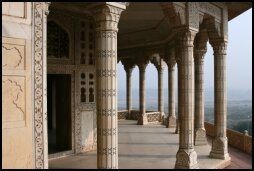 12-11-2008 Walking through the still foggy streets of Agra we're headed to the famous Fort, constructed by Moghul Akbar. A watery sun is climbing higher and higher in the grey sky and the red stones of the castle walls seem to be glowing in the beautiful morning light. Within the fort we see lots of marble, sometime even inlaid with colourful little gems. It's obvious this once was Muslim territory, but the strict athmosphere carried out by bearded men and veiled women, we've experienced in Eastern Turkey is not present here at all. It's a lovely structure and still in a good condition. A nice extra are the cute chipmunks of whom large numbers are living in the castle gardens.
12-11-2008 Walking through the still foggy streets of Agra we're headed to the famous Fort, constructed by Moghul Akbar. A watery sun is climbing higher and higher in the grey sky and the red stones of the castle walls seem to be glowing in the beautiful morning light. Within the fort we see lots of marble, sometime even inlaid with colourful little gems. It's obvious this once was Muslim territory, but the strict athmosphere carried out by bearded men and veiled women, we've experienced in Eastern Turkey is not present here at all. It's a lovely structure and still in a good condition. A nice extra are the cute chipmunks of whom large numbers are living in the castle gardens.
 By the end of the morning we're walking through the busy streets of the old city to the Jama Mosque, another fabulous structure with onion shaped domes, decorated with marble patterns. In the vicinity of the mosque there's a lot of activity, consisting of little shops and streetstalls selling the most divergent products. Donkeys, buffaloes and oxen are walking among all the tuktuks, rikshaws and pedestrians and the contrast with the quiet square surrounding the mosque is huge.
By the end of the morning we're walking through the busy streets of the old city to the Jama Mosque, another fabulous structure with onion shaped domes, decorated with marble patterns. In the vicinity of the mosque there's a lot of activity, consisting of little shops and streetstalls selling the most divergent products. Donkeys, buffaloes and oxen are walking among all the tuktuks, rikshaws and pedestrians and the contrast with the quiet square surrounding the mosque is huge.
After a short visit to the interior of the mosque we take a rikshaw to the Itimad-Ud-Daulah, also called Baby Taj. When this tomb of Mizra Ghiyas Beg really is a foretaste for what we'll see tomorrow we're already enthusiastic about the Taj Mahal. The marble walls have been carved extremely detailed and are inlaid with stone and the symmetry of the structure is exceptionally beautiful.
In an autorikshaw we now risk ourselves in the bustle of Agra to go to the Akbar Mausoleum some ten kilometers further on. In the large gardens of the structure we see antilopes, langurs (monkeys), macaques and many kinds of butterflies and various of birds, like parrots. We're surprised by the large number of animals in Indian cities, the average wild park would find it hard to compete. The beauty of all the buildings we've visited today also positively surprised us and tired but happy we return to our room.
> Taj Mahal
13-11-2008 Today it's thé day. We're ready to visit Indias best known tourist attraction, the Taj Mahal. The queues are long, but Yvonne soon gets to the front of the special ladies line. Here the two books, a whistle, our laptop and all the balloons and hairpins she's got in her bag are marked as forbidden items and we're sent away to put them in a locker. Back in line Peter is unlucky too: green dolls (how dare they call our Treelo a green doll!) are also not allowed and we need to get back to the lockers for the second time. Now they really can't find another reason to send us away and there we go, through the entrance gate of the symbol of India.
We do think it's pretty, but we're not overwhelmed, like so many others are. Yesterday we've seen some buildings at least as beautiful and we think the Taj is mostly very big. However, we've just payed an
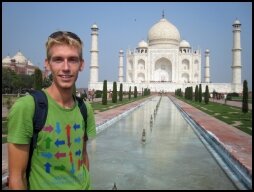 Indian salary to enter the place and now we'll be checking out every corner to make the most of it. It takes us about two hours, including a photo session at the wellknown reflecting fountains.
Indian salary to enter the place and now we'll be checking out every corner to make the most of it. It takes us about two hours, including a photo session at the wellknown reflecting fountains.
> Fatehpur Sikri
14-11-2008 Fatehpur Sikri is the city about fourty kilometers from Agra, constructed by Akbar and abandoned ages ago. We go there by bus, to explore the ghost city with our own eyes, but except for the big mosque and the impressive entrance gate we find the place rather disappointing.
For some twenty Indians it's hard to wait for all the current passengers to get off, as the return bus shows up. One of them has been stuck for a while, between the door and someone who's just trying to get off. He keeps pushing through, even though he must know better than this. Fortunately schoolteacher Yvonne is there to explain to him that this is not working. Somehow he understands and he moves to the side to let the people who are still in the bus get off first. As soon as the last passenger finally reached the bottom step three waiting Indians from outside rush through the doorway, shoulder to shoulder. Next there's a lot of pulling and pushing. Those twenty people seem to find it hard to understand there's enough seats for all of them in a bus with fifty seats. We think it's yet another an entertaining experience.
15-11-2008 Today we feel like relaxing and we don't do much more than reading a book. Tomorrow we'll have another day like this to move on to Rajasthan the day after. Our first stop will be Jaipur: the Pink City.
Varanasi Ghats videoThe Varanasi Ghats video will show here |
Agra streetlife videoThe Agra streetlife video will show here |
Click on the films up here to look around in Varanasi and Agra, almost live.
> More Info
Also check our India info page, where you can find a lot of information about India and come see our Uttar Pradesh photos.